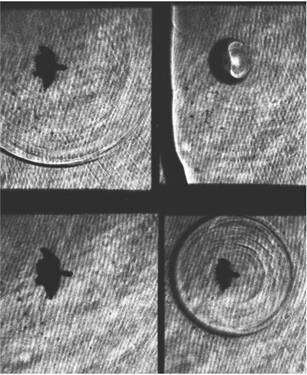In the Institute of High Speed Mechanics, Tohoku University (renamed in 1989 as the Institute of Fluid Science, IFS) specialized the cavitation research and hence when we initiated shock wave research, one of our research topics was related to underwater shock wave and bubble dynamics [1]. We then realized that conventional shock tubes were useless to generate strong underwater shock waves and electric discharges and wire explosions were not necessarily suited to reliably create underwater shock waves. In 1980, we adopted underwater micro-explosions by detonating lead azide pellets of 1.0mg to several ten mg in weight that produced in house and ignited the micro-explosives by Q-switch laser beam irradiation. Then the underwater shock waves were generated reliably and safely in laboratory scale. We were interested in optical flow visualization of underwater shock waves by using traditional shadowgraph or schlieren method. In 1980 we developed double exposure holographic interferometry and were able to quantitatively observe the underwater shock waves [2]. Since then, we produced over two thousands holographic images and shadowgrams of underwater shock waves and several thousand interfergrams of shock tube flows. The images so far collected are the base line of our shock wave application to medicine. Only topical images have been selectively published mostly in the internal circulations or in the symposium proceedings.
To demonstrate a result, in Fig.1, see sequential images, running from top to bottom and from right to left, obtained by ImaCon at the framing rate of 106 frames/s of shock interaction with a helium bubble of 20mm in diameter at the standoff distance of 10mm. The bubble was impinged by an underwater shock wave at over-pressure of over 100MPa generated by explosion of 10mg silver azide. The emission of luminosity at the contracting bubble and the process of a secondary shock wave formation or a coalescence of compression waves from the collapsing bubble were observed. Probably it is a new finding that a jet formed to the reverse direction at the bubble collapse from what we observed during underwater shock/air bubble interaction. This observation implies that in the shock/bubble interaction, the waves inside the contracting bubble affected the bubble motion afterward, that is, the ratio of the liquid sound speed to gas sound speed should be a parameter that decisively governs the mode of shock/bubble interaction. This will be a basic topic in handling liquid hydrogen. We do hope that this figure would stimulate for CFD experts to try to reproduce these images.

Fig.1 Underwater shock wave interaction with a 20mm He bubble.
In this presentation, chronological descriptions of images of shock/bubble interaction are following:
Shock wave propagation over silicone oil surface in1981
Shock/bubble interaction in ultrasonic oscillatory tests in 1981 - 1982
Shock waves generated by underwater discharge 1982
Shock interaction with bubble cloud in 1983
Shock interaction with extracted tissues in 1983
Shock wave focusing from truncated ellipsoidal reflectors and kidney stone disintegrations 1983 – 1984
Shock wave reflection from shallow truncated ellipsoidal reflector in 1984
Sympathetic explosion triggered by bubble collapse in 1984
Measurements of acoustic impedances of extracted tissues in 1984
Focusing of underwater shock wave generated by Q-switched laser beams irradiation on concave walls in 1984
Shock reflection from liquid wedges in 1985
Shock interaction with a bubble on gelatin surface 1985
Generation of spherical shock in acrylic and glass plates in 1985
Shock interaction with a bubble sandwiched by acrylic plates in 1986
Shock interaction with a bubble inserted in a dent on acrylic plate in 1986
Shock focusing in closed elliptical cavity 1987
Shock interaction with ascending bubble cloud in 1988
Shock interaction with a bubble in silicon oil of various viscosities in 1991
Shock interaction with a bubble on gelatin and acrylic surfaces, high-speed imaging by ImaCon in 1991
Shock interaction with He bubble by ImaCon framing in 1992
Ultrasound wave focusing 1992
Shock interaction with bubbles on gelatin surface in 1995
Shock propagation along arrayed glass beads, arrayed acrylic cylinders, ANFO beads, and gelatin spheres in 1995
Shock reflection from underwater conical shock waves generated by MDF 1996
[1] K. Takayama and O. Igra: Tribute and Memory of Professor I. I. Glass, Springer Verlag, Heidelberg (2012).
[2] K. Takayama: Application of double exposure holographic interferometry to shock wave research, SPIE Proc. Vol. 389, (1983). .

